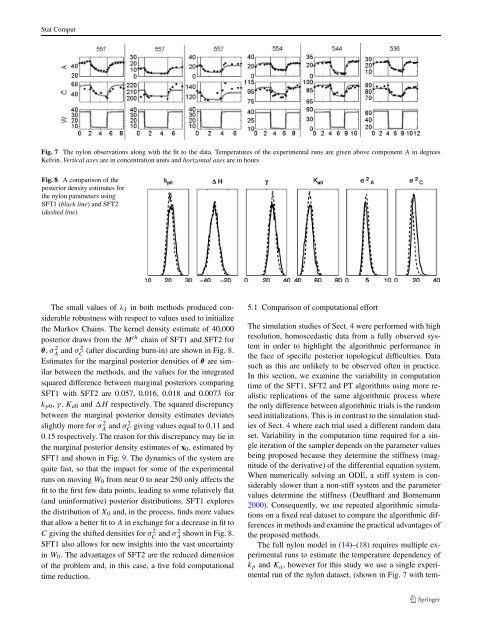Smooth functional tempering for nonlinear differential equation models
Smooth functional tempering for nonlinear differential equation models
Smooth functional tempering for nonlinear differential equation models
Create successful ePaper yourself
Turn your PDF publications into a flip-book with our unique Google optimized e-Paper software.
Stat ComputFig. 7 The nylon observations along with the fit to the data. Temperatures of the experimental runs are given above component A in degreesKelvin. Vertical axes are in concentration units and horizontal axes are in hoursFig. 8 A comparison of theposterior density estimates <strong>for</strong>the nylon parameters usingSFT1 (black line) and SFT2(dashed line)The small values of λ 1 in both methods produced considerablerobustness with respect to values used to initializethe Markov Chains. The kernel density estimate of 40,000posterior draws from the M th chain of SFT1 and SFT2 <strong>for</strong>θ,σA 2 and σ C 2 (after discarding burn-in) are shown in Fig. 8.Estimates <strong>for</strong> the marginal posterior densities of θ are similarbetween the methods, and the values <strong>for</strong> the integratedsquared difference between marginal posteriors comparingSFT1 with SFT2 are 0.057, 0.016, 0.018 and 0.0073 <strong>for</strong>k p0 , γ,K a0 and H respectively. The squared discrepancybetween the marginal posterior density estimates deviatesslightly more <strong>for</strong> σA 2 and σ C 2 giving values equal to 0.11 and0.15 respectively. The reason <strong>for</strong> this discrepancy may lie inthe marginal posterior density estimates of x 0 , estimated bySFT1 and shown in Fig. 9. The dynamics of the system arequite fast, so that the impact <strong>for</strong> some of the experimentalruns on moving W 0 from near 0 to near 250 only affects thefit to the first few data points, leading to some relatively flat(and unin<strong>for</strong>mative) posterior distributions. SFT1 exploresthe distribution of X 0 and, in the process, finds more valuesthat allow a better fit to A in exchange <strong>for</strong> a decrease in fit toC giving the shifted densities <strong>for</strong> σC 2 and σ A 2 showninFig.8.SFT1 also allows <strong>for</strong> new insights into the vast uncertaintyin W 0 . The advantages of SFT2 are the reduced dimensionof the problem and, in this case, a five fold computationaltime reduction.5.1 Comparison of computational ef<strong>for</strong>tThe simulation studies of Sect. 4 were per<strong>for</strong>med with highresolution, homoscedastic data from a fully observed systemin order to highlight the algorithmic per<strong>for</strong>mance inthe face of specific posterior topological difficulties. Datasuch as this are unlikely to be observed often in practice.In this section, we examine the variability in computationtime of the SFT1, SFT2 and PT algorithms using more realisticreplications of the same algorithmic process wherethe only difference between algorithmic trials is the randomseed initializations. This is in contrast to the simulation studiesof Sect. 4 where each trial used a different random dataset. Variability in the computation time required <strong>for</strong> a singleiteration of the sampler depends on the parameter valuesbeing proposed because they determine the stiffness (magnitudeof the derivative) of the <strong>differential</strong> <strong>equation</strong> system.When numerically solving an ODE, a stiff system is considerablyslower than a non-stiff system and the parametervalues determine the stiffness (Deuflhard and Bornemann2000). Consequently, we use repeated algorithmic simulationson a fixed real dataset to compare the algorithmic differencesin methods and examine the practical advantages ofthe proposed methods.The full nylon model in (14)–(18) requires multiple experimentalruns to estimate the temperature dependency ofk p and K a , however <strong>for</strong> this study we use a single experimentalrun of the nylon dataset, (shown in Fig. 7 with tem-
















